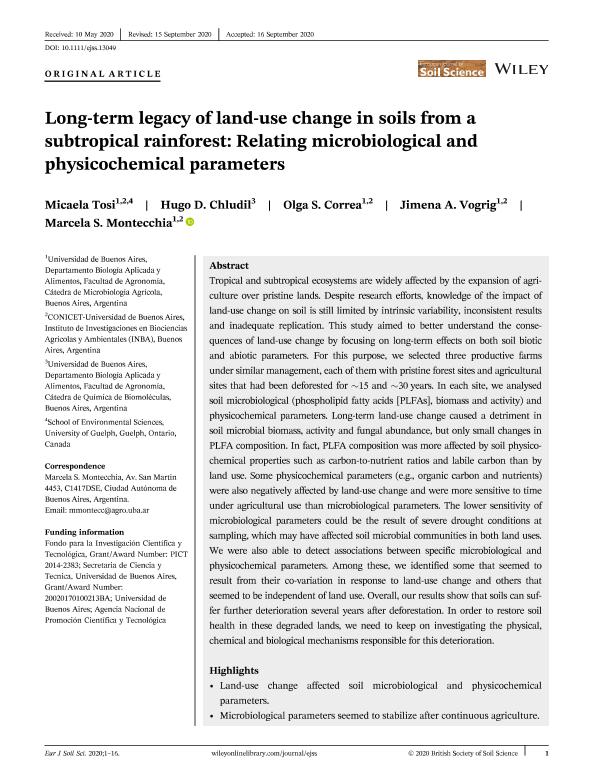Mostrar el registro sencillo del ítem
dc.contributor.author
Tosi, Micaela

dc.contributor.author
Chludil, Hugo Daniel

dc.contributor.author
Correa, Olga Susana

dc.contributor.author
Vogrig, Jimena Andrea

dc.contributor.author
Montecchia, Marcela Susana

dc.date.available
2022-02-17T12:18:02Z
dc.date.issued
2020-09
dc.identifier.citation
Tosi, Micaela; Chludil, Hugo Daniel; Correa, Olga Susana; Vogrig, Jimena Andrea; Montecchia, Marcela Susana; Long-term legacy of land-use change in soils from a subtropical rainforest: Relating microbiological and physicochemical parameters; Wiley Blackwell Publishing, Inc; European Journal Of Soil Science; 72; 2; 9-2020; 1054-1069
dc.identifier.issn
1351-0754
dc.identifier.uri
http://hdl.handle.net/11336/152196
dc.description.abstract
Tropical and subtropical ecosystems are widely affected by the expansion of agriculture over pristine lands. Despite research efforts, knowledge of the impact of land-use change on soil is still limited by intrinsic variability, inconsistent results and inadequate replication. This study aimed to better understand the consequences of land-use change by focusing on long-term effects on both soil biotic and abiotic parameters. For this purpose, we selected three productive farms under similar management, each of them with pristine forest sites and agricultural sites that had been deforested for ~15 and ~30 years. In each site, we analysed soil microbiological (phospholipid fatty acids [PLFAs], biomass and activity) and physicochemical parameters. Long-term land-use change caused a detriment in soil microbial biomass, activity and fungal abundance, but only small changes in PLFA composition. In fact, PLFA composition was more affected by soil physicochemical properties such as carbon-to-nutrient ratios and labile carbon than by land use. Some physicochemical parameters (e.g., organic carbon and nutrients) were also negatively affected by land-use change and were more sensitive to time under agricultural use than microbiological parameters. The lower sensitivity of microbiological parameters could be the result of severe drought conditions at sampling, which may have affected soil microbial communities in both land uses. We were also able to detect associations between specific microbiological and physicochemical parameters. Among these, we identified some that seemed to result from their co-variation in response to land-use change and others that seemed to be independent of land use. Overall, our results show that soils can suffer further deterioration several years after deforestation. In order to restore soil health in these degraded lands, we need to keep on investigating the physical, chemical and biological mechanisms responsible for this deterioration. Highlights: Land-use change affected soil microbiological and physicochemical parameters. Microbiological parameters seemed to stabilize after continuous agriculture. Soil organic C, total N and fine particles were still reduced after long-term cultivation. Microbiological parameters were mostly associated with C-to-nutrient ratios and labile C. Drought conditions may have affected microbial response to land-use change.
dc.format
application/pdf
dc.language.iso
eng
dc.publisher
Wiley Blackwell Publishing, Inc

dc.rights
info:eu-repo/semantics/openAccess
dc.rights.uri
https://creativecommons.org/licenses/by-nc-sa/2.5/ar/
dc.subject
DEFORESTATION
dc.subject
MICROBIAL ACTIVITY
dc.subject
MICROBIAL BIOMASS
dc.subject
PLFA
dc.subject
SOIL ORGANIC CARBON
dc.subject
YUNGAS
dc.subject.classification
Otras Ciencias Agrícolas

dc.subject.classification
Otras Ciencias Agrícolas

dc.subject.classification
CIENCIAS AGRÍCOLAS

dc.title
Long-term legacy of land-use change in soils from a subtropical rainforest: Relating microbiological and physicochemical parameters
dc.type
info:eu-repo/semantics/article
dc.type
info:ar-repo/semantics/artículo
dc.type
info:eu-repo/semantics/publishedVersion
dc.date.updated
2021-04-28T21:30:45Z
dc.journal.volume
72
dc.journal.number
2
dc.journal.pagination
1054-1069
dc.journal.pais
Reino Unido

dc.journal.ciudad
Londres
dc.description.fil
Fil: Tosi, Micaela. Consejo Nacional de Investigaciones Científicas y Técnicas. Oficina de Coordinación Administrativa Parque Centenario. Instituto de Investigaciones en Biociencias Agrícolas y Ambientales. Universidad de Buenos Aires. Facultad de Agronomía. Instituto de Investigaciones en Biociencias Agrícolas y Ambientales; Argentina
dc.description.fil
Fil: Chludil, Hugo Daniel. Universidad de Buenos Aires. Facultad de Agronomía. Departamento de Biología Aplicada y Alimentos; Argentina
dc.description.fil
Fil: Correa, Olga Susana. Consejo Nacional de Investigaciones Científicas y Técnicas. Oficina de Coordinación Administrativa Parque Centenario. Instituto de Investigaciones en Biociencias Agrícolas y Ambientales. Universidad de Buenos Aires. Facultad de Agronomía. Instituto de Investigaciones en Biociencias Agrícolas y Ambientales; Argentina
dc.description.fil
Fil: Vogrig, Jimena Andrea. Consejo Nacional de Investigaciones Científicas y Técnicas. Oficina de Coordinación Administrativa Parque Centenario. Instituto de Investigaciones en Biociencias Agrícolas y Ambientales. Universidad de Buenos Aires. Facultad de Agronomía. Instituto de Investigaciones en Biociencias Agrícolas y Ambientales; Argentina
dc.description.fil
Fil: Montecchia, Marcela Susana. Consejo Nacional de Investigaciones Científicas y Técnicas. Oficina de Coordinación Administrativa Parque Centenario. Instituto de Investigaciones en Biociencias Agrícolas y Ambientales. Universidad de Buenos Aires. Facultad de Agronomía. Instituto de Investigaciones en Biociencias Agrícolas y Ambientales; Argentina
dc.journal.title
European Journal Of Soil Science

dc.relation.alternativeid
info:eu-repo/semantics/altIdentifier/url/https://onlinelibrary.wiley.com/doi/full/10.1111/ejss.13049
dc.relation.alternativeid
info:eu-repo/semantics/altIdentifier/doi/http://dx.doi.org/10.1111/ejss.13049
Archivos asociados
